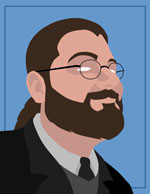This morning I finished reading Michael Chabon’s new collection of essays Maps and Legends (2008, McSweeney’s Books). I knew that I enjoyed Chabon’s work from the few essays and chapters of his I’ve read already, but this one really knocked it out of the park. An embarrassed confession: I have yet to finish reading The Amazing Adventures of Kavalier and Clay, as I got pulled away from it to read something else (as happens all too frequently in my life), but this one was such an amazing page-turner that even though I was also reading several other books at the same time (I also finished Ian Fleming’s Casino Royale yesterday), I kept getting pulled back to it.
I’m perfectly comfortable in admitting that Maps and Legends may be one of those right-place-right-time books for me, and that your mileage may vary – but as it is, Chabon’s words pierced me through the heart like a perfectly aimed barrage of arrows. Or, to mix and mangle metaphors, reading his thoughts about genre and literature is like being a private listening to a grizzled veteran general telling tales of his life in the trenches.
Chabon talks about how he grew up loving genre works like science fiction and noir detective stories, and then feeling the sting of the ‘literary’ in his creative writing workshops in college, which is precisely the same thing that I went through, and how that affected his decision to shelve his genre work in favor of the more literary texts that would become his first and second published novels, The Mysteries of Pittsburgh and Wonder Boys. Examining his career arc is incredibly informative: he played by the rules with these literary texts and then continued on to write Kavalier and Clay, which mixed the literary with touches of genre, and now he’s trending more towards genre with touches of literary in his most recent work Gentlemen of the Road.
I look at this as a sort of inverted career path to someone like Neil Gaiman, who began his career in comics and has been playing in other media ever since. What’s particularly fascinating is how “literary” Chabon won the Pulitzer but the World Fantasy Award people changed the rules after “pulp” Gaiman’s A Midsummer Night’s Dream took the cookie so a comic could never win again. To me, this smacks of branding more than literary achievement: if you start out as a genre writer, you will always be branded as such, but if you start out as literary you may be tolerated your dalliances in the lower arts. Of course this is primarily being done by the literati – the flipside of this type of judgement would be, I suppose, the fiscal and readership measuring sticks, both of which I suspect Gaiman would win by a wide margin. Then again, Chabon has had several movie deals already, so my guessing which of them has established a bigger family fortune is both crass and pointless. Still, as someone measuring his idols to plot out a plan for the immediate future, all this conjecture does serve a purpose. Whether or not any hard data can be obtained from this research is irrelevant – the exercise in itself is illuminating.
Long story short, Maps and Legends is a terrific collection of essays, extremely readable and enjoyable and educational all bundled together – and exactly what you’re looking for if you’re a would-be up-and-comer trying to navigate the tricky borderlands between high and low culture, genre and literary fiction, academia and pop intellectualism. Add to that the additional niceties that proceeds from the book go to support Dave Eggers’ 826 Valencia literary project for kids and that this hardcover edition is easily one of the most beautifully-designed literary artifacts I own (the multi-layered dust jacket has be experienced to be believed), I can easily and happily say that Maps and Legends is a must-have, highly recommended, five stars, three thumbs up and so on. Buy it.

Storyteller, scholar, consultant. Loving son, husband and father. Kindhearted mischief-maker.
I'm the Director of the Games and Simulation program at Miami University in Ohio, where I am also an Assistant Professor in the College of Creative Arts' Emerging Technology in Business and Design department. I'm also the director of Miami's Worldbuilding and Narrative Design Research Laboratory (WNDRLab). I have a Master's in Comparative Media Studies from MIT and a PhD in Media Arts and Practices from the University of Southern California.
In past lives I've been the lead Narrative Producer for Microsoft Studios and cofounder of its Narrative Design team, working on projects like Hololens, Quantum Break and new IP incubation; in a "future of media" think tank for Microsoft's CXO/CTO and its Chief Software Architect; the Creative Director for the University of Southern California's World Building Media Lab and the Technical Director, Creative Director and a Research Fellow for USC's Annenberg Innovation Lab; a Visiting Assistant Professor at Whittier College and director of its Whittier Other Worlds Laboratory (WOWLab); the Communications Director and a researcher for the Singapore-MIT GAMBIT Game Lab; a founding member of the Convergence Culture Consortium at MIT (now The Futures of Entertainment); a magazine editor; and a award-winning short film producer. more »
The opinions put forward in this blog are mine alone, and do not reflect the opinions of my employers.

